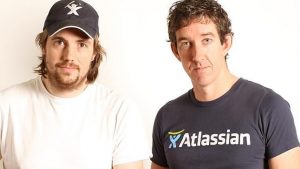Atlassian’s start-up story could bring a tear to even the most jaded Silicon Valley veteran’s eye. Setting the scene, there is working class hero Scott Farquhar who, as a child, spent almost a year trying to get an old Wang computer to play his favorite computer games. On the other side of town, there is Michael Cannon-Brookes, who was educated at one of Sydney’s most exclusive boys’ schools and bought his first computer with frequent flyer points while in primary school.
Despite their divergent backgrounds, the boys met at the University of South Whales after being accepted to the same business information technology scholarship course. They weren’t exactly fast friends by the end of day one but it didn’t take long for them to find their clique.
As fellow university classmate Nick Scevak described it, the bonds of geek transcended even those of race, color or creed. “We came from all walks of life but we were all nerds who loved computers,” he remembered. “From the very first day, people hung out and were friends.”
It was the beginning of a life-long friendship and the basis for a fledgling IT firm floated on a hope, a prayer and $10,000 of credit card debt. In 2002, the dynamic duo rolled out their initial offering of JIRA, a tool for issue-tracking and project management. The corporate landscape was very different at that time, the world was still recovering from the dot.com crash and those deemed responsible for that dark time were often relegated to the hinterlands of corporate decision-making.
There were set divisions within the world and companies operated as silos within their industry. One common theme, however, was that IT was an afterthought. Software was a cookie-cutter product sold en masse, installed on company hardware and forgotten about until something broke down. Development teams were frequently housed offsite and didn’t contribute much to company direction. Jira came about as a way for software developers to document their work and track bugs.
The advent of the “Agile” approach – the process of developing software through close collaboration between business units and software developers; small but frequent updates; and greater transparency about what was being built – contributed greatly to the rising popularity of Jira. This worked in tandem with advances in smart phone technology and the ready accessibility of the internet to sell their applications and compete with bigger companies.
“You could look at our evolution as, we became indispensable for developers, and then two things happened. Developers became king-makers inside organizations, and then everyone realized, you know, hang on, we need to work in a different way,” Farquhar says.
“And so both of those mean the way developers track work is now the way everyone wants to track work. And every company is becoming a software company.”
The company spent many years operating slightly out of step with industry practice – they published product prices on their website so customers couldn’t get gouged; they didn’t hire salespeople and focused on creating easy-to-use software applications that were adopted within the IT community.
It didn’t take long before technology started to move beyond its role as a helpful way to do business to the only way to do business. In a strange reversal of roles, developers became the decision-makers and all those grasshopper-companies that didn’t heed the warning of the hardworking dot.com ant learned what happened when winter came.
Since then, they can now count NASA, Audi, Telstra and Virgin Media as among their customers.. Farquhar and Cannon-Brooks ran their company lean for the first eight years and still own two-thirds of the business they built together. Accel Partners paid $60 million for 20 percent of the company and other equity was given to employees. In April 2014, T. Price Rowe & Dragoneer Investment Capital bought 6 percent equity from Accel and some staff for $3.3 billion.
The company went public in 2015 and through a series of acquisitions, have grown their company to 3,000 employees, expanded their suite of tools and have more than 1,000 customers spanning the globe.
























